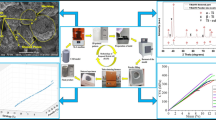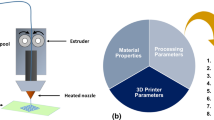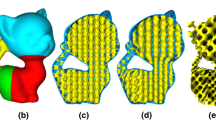Abstract
Additive manufacturing (AM) recently has been changing from conventional Rapid prototyping (RP) to direct fabrication of functional parts. As a direct fabrication method, a promising application of AM is to make personalized or customized parts; biomedical applications customized to human’s bodies can provide improved functionalities for an example. In this study, a customized plastic cast is developed to replace traditional plaster casts. For customization, its basic shape is defined out of three-dimensional (3d) scan data of a human arm. This cast is designed to have a number of holes for lighter weight and better ventilation, and to be printed using a Material extrusion (ME) type 3d printer that uses thermoplastic polymer filaments. Finite element (FE) analyses are then performed to evaluate the structural safety and stiffness of the printed cast with porosity. Considering that the structural safety and stiffness are degenerated due to the porous structure, design reinforcements are suggested to improve the bending stiffness of the porous cast. FE analyses are then performed with variations of design parameters of the reinforcement structures, from which we obtain the best design candidate that provides higher specific stiffness than the conventional solid structure. A porous-customized cast with lighter weight and better ventilation can thereby be developed successfully.
Similar content being viewed by others
References
I. Campbell, D. Bourell and I. Gibson, Additive manufacturing: Rapid prototyping comes of age, Rapid Prototyping J., 18 (4) (2012) 225–258.
C. M. B. Ho, S. H. Ng and Y. J. Yoon, A review on 3D printed bioimplants, Int. J. Precis. Eng. Manuf., 16 (5) (2015) 1035–1046.
R. K. Chen, Y. A. Jin, J. Wensman and A. Shih, Additive manufacturing of custom orthoses and prostheses—A review, Additive Manufact., 12 (2016) 77–89.
M. T. Fitch, B. A. Nicks, M. Pariyadath, H. D. McFinnis and D. E. Manthey, Basic splinting techniques, New England J. Medicine, 359 (26) (2008) e32.
M. C. Faustini, R. R. Neptune, R. H. Crawford and S. J. Stanhope, Manufacture of passive dynamic ankle-foot orthoses using selective laser sintering, IEEE Trans. Biomed. Eng., 55 (2) (2008) 784–790.
D. Cook, V. Gervasi, R. Rizza, S. Kamara and X. C. Liu, Additive fabrication of custom pedorthoses for clubfoot correction, Rapid Prototyping J., 16 (3) (2010) 189–193.
C. Mavroidis, R. G. Ranky, M. K. Sivak, B. L. Patritti, J. DiPisa, A. Caddle, K. Filhooly, L. Govoni, S. Sivak, M. Lancia, R. Drillio and P. Bonago, Patient specific ankle-foot orthoses using rapid prototyping, J. Neuroeng. Rehabil., 8 (1) (2011) 1–11.
D. Palousek, J. Rosicky, D. Koutny, P. Stoklásek and T. Navrat, Pilot study of the wrist orthosis design process, Rapid Prototyping J., 20 (1) (2014) 27–32.
H. Kim and S. Jeong, Case study: Hybrid model for the customized wrist orthosis using 3D printing, J. Mech. Sci. Technol., 29 (12) (2015) 5151–5156.
A. M. Paterson, R. Bibb, R. I. Campbell and G. Bingham, Comparing additive manufacturing technologies for customised wrist splints, Rapid Prototyping J., 21 (3) (2015) 230–243.
CORTEX, http://www.evilldesign.com/cortex.
OSTEOID, http://www.osteoid.com.
H. Ko, S. K. Moon and K. Hwang, Design for additive manufacturing in customized products, Int. J. Precis. Eng. Manuf., 16 (11) (2015) 2369–2375.
M. K. Thompson, G. Moroni, T. Vaneker, G. Fadel, R. I. Campbell, I. Gibson and F. Martina, Design for additive manufacturing: trends, opportunities, considerations, and constraints, CIRP Annl. Manuf. Technol., 65 (2) (2016) 737–760.
S. Jang, C. H. Goh and H. J. Choi, Multiphase design exploration method for lightweight structural design: Example of vehicle mounted antenna-supporting structure, Int. J. Precis. Eng. Manuf. Green Tech., 2 (2) (2015) 281–287.
C. Chu, G. Graf and D. W. Rosen, Design for additive manufacturing of cellular structures, Computer-Aided Design Appl., 5 (5) (2008) 686–696.
J. Chu, S. Engelbrecht, G. Graf and D. W. Rosen, A comparison of synthesis methods for cellular structures with application to additive manufacturing, Rapid Prototyping J., 16 (4) (2010) 275–283.
D. J. Yoo, New paradigms in cellular material design and fabrication, Int. J. Precis. Eng. Manuf., 16 (12) (2015) 2577–2589.
X. Y. Kou and S. T. Tan, A simple and effective geometric representation for irregular porous structure modeling, Computer-Aided Design, 42 (10) (2010) 930–941.
D. J. Yoo and K. H. Kim, An advanced multi-morphology porous scaffold design method using volumetric distance field and beta growth function, Int. J. Precis. Eng. Manuf., 16 (9) (2015) 2021–2032.
W. Wang, T. Y. Wang, Z. Yang, L. Liu, X. Tong, W. Tong, J. Deng, F. Chen and X. Liu, Cost-effective printing of 3D objects with skin-frame structures, ACM Trans. Graph., 32 (6) (2013) 177.
L. Lu, A. Sharf, H. Zhao, Y. Wei, Q. Fan, X. Chen, Y. Savoye, C. Tu, D. Cohen-Or and B. Chen, Build-to-last: Strength to weight 3D printed objects, ACM Trans. Graph., 33 (4) (2014) 97.
Y. E. Lim and K. Park, Investigation of bending stiffness of porous shell structures fabricated by 3D printing, Trans. KSME (A), 41 (6) (2017) 491–497.
J. Cho, J. Koo and H. Jung, A lightweight design approach for an EMU carbody using a material selection method and size optimization, J. Mech. Sci. Technol., 30 (2) (2016) 673–681.
Author information
Authors and Affiliations
Corresponding author
Additional information
Recommended by Editor Haedo Jeong
Yeong-Eun Lim is a master candidate in the Department of Mechanical Design and Robot Engineering at Seoul National University of Science and Technology, Korea. She received a B.S. from Seoul National University of Science and Technology in 2015. Her current research includes design and analysis of lightweight structure for additive manufacturing.
Keun Park received his B.S. and M.S. degrees in Precision Engineering and Mechatronics from KAIST, Korea, in 1992 and 1994, respectively. He then received his Ph.D. degree in Mechanical Engineering from KAIST in 1999. Dr. Park is currently a Professor of the Department of Mechanical System Design Engineering at Seoul National University of Science and Technology, Korea. His research interests include numerical analysis of material forming processes, micro-fabrication, and additive manufacturing.
Rights and permissions
About this article
Cite this article
Lim, YE., Kim, NH., Choi, HJ. et al. Design for additive manufacturing of customized cast with porous shell structures. J Mech Sci Technol 31, 5477–5483 (2017). https://doi.org/10.1007/s12206-017-1042-z
Received:
Revised:
Accepted:
Published:
Issue Date:
DOI: https://doi.org/10.1007/s12206-017-1042-z




